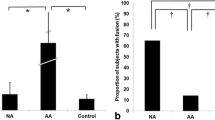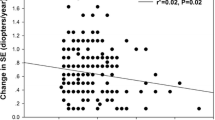Abstract
Purpose
To investigate the correlation between stereoacuity, as analyzed by the Titmus stereotest, and the severity of myopia, astigmatism and anisometropia in a school-aged population in Taiwan.
Methods
Cycloplegic autorefraction, best corrected monocular visual acuity and stereoacuity were measured in 6- to 18-year-old school children. Children with amblyopia (best corrected visual acuity of <20/25) or strabismus were excluded from this study. The correlation between stereoacuity and the severity of myopia, astigmatism and anisometropia was analyzed by the Titmus stereotest.
Results
A total of 166 children (95 boys, 71 girls; mean age 10.75 years, range 6–18 years) with myopia or astigmatism were enrolled in the study. The mean spherical error was −2.22 ± 1.70 diopters (D) (range −0.25 to −9.50 D), and the mean astigmatism was −0.72 ± 0.89 (range 0 to −4.50) D. An anisometropia of >1.00 D and spherical anisometropia of >1.00 D were strongly associated with decreased stereoacuity on the Titmus stereotest (P < 0.001). Astigmatism was also correlated with the performance of stereopsis (P = 0.013).
Conclusion
Anisometropia (>1.00 D), spherical anisometropia (>1.00 D), and astigmatism were associated with reduced stereoacuity in school-aged children.
Similar content being viewed by others
References
van Ee R, Erkelens CJ. Stability of binocular depth perception with moving head and eyes. Vision Res. 1996;36:3827–42.
Hong SW, Park SC. Development of distant stereoacuity in visually normal children as measured by the Frisby–Davis distance stereotest. Br J Ophthalmol. 2008;92:1186–9.
Hrisos S, Clarke MP, Kelly T, Henderson J, Wright CM. Unilateral visual impairment and neurodevelopmental performance in preschool children. Br J Ophthalmol. 2006;90:836–8.
Levy NS, Glick EB. Stereoscopic perception and Snellen visual acuity. Am J Ophthalmol. 1974;78:722–4.
Kim SH, Plager DA. Stereopsis in children with unilateral pseudophakia. Br J Ophthalmol. 2009;93:333–6.
Oguz H, Oguz V. The effects of experimentally induced anisometropia on stereopsis. J Pediatr Ophthalmol Strabismus. 2000;37:214–8.
Chen SI, Hove M, McCloskey CL, Kaye SB. The effect of monocularly and binocularly induced astigmatic blur on depth discrimination is orientation dependent. Optom Vis Sci. 2005;82:101–13.
Fujikado T, Morimoto T, Shimojyo H. Development of anisometropia in patients after surgery for esotropia. Jpn J Ophthalmol. 2010;54:589–93.
von Noorden GK, Avilla CW. Accommodative convergence in hypermetropia. Am J Ophthalmol. 1990;110:287–92.
Mai GH. Stereoacuity and ametropia (in Chinese). Zhonghua Yan Ke Za Zhi. 1993;29:280–2.
Weakley DR Jr. The association between nonstrabismic anisometropia, amblyopia, and subnormal binocularity. Ophthalmology. 2001;108:163–71.
Jamali P, Fotouhi A, Hashemi H, Younesian M, Jafari A. Refractive errors and amblyopia in children entering school: Shahrood, Iran. Optom Vis Sci. 2009;86:364–9.
Dobson V, Harvey EM, Miller JM, Clifford-Donaldson CE. Anisometropia prevalence in a highly astigmatic school-aged population. Optom Vis Sci. 2008;85:512–9.
Kleinstein RN, Jones LA, Hullett S, Kwon S, Lee RJ, Friedman NE, et al. Refractive error and ethnicity in children. Arch Ophthalmol. 2003;121:1141–7.
Robaei D, Rose K, Ojaimi E, Kifley A, Huynh S, Mitchell P. Visual acuity and the causes of visual loss in a population-based sample of 6-year-old Australian children. Ophthalmology. 2005;112:1275–82.
Murthy GV, Gupta SK, Ellwein LB, Munoz SR, Pokharel GP, Sanga L, et al. Refractive error in children in an urban population in New Delhi. Invest Ophthalmol Vis Sci. 2002;43:623–31.
He M, Zeng J, Liu Y, Xu J, Pokharel GP, Ellwein LB. Refractive error and visual impairment in urban children in southern China. Invest Ophthalmol Vis Sci. 2004;45:793–9.
Naidoo KS, Raghunandan A, Mashige KP, Govender P, Holden BA, Pokharel GP. Refractive error and visual impairment in African children in South Africa. Invest Ophthalmol Vis Sci. 2003;44:3764–70.
Negrel AD, Maul E, Pokharel GP, Zhao J, Ellwein LB. Refractive error study in children: sampling and measurement methods for a multi-country survey. Am J Ophthalmol. 2000;129:421–6.
Logan NS, Gilmartin B. School vision screening, ages 5–16 years: the evidence-base for content, provision and efficacy. Ophthalmic Physiol Opt. 2004;24:481–92.
Huynh SC, Wang XY, Ip J, Robaei D, Kifley A, Rose KA, et al. Prevalence and associations of anisometropia and aniso-astigmatism in a population based sample of 6 year old children. Br J Ophthalmol. 2006;90:597–601.
Farbrother JE. Spectacle prescribing in childhood: a survey of hospital optometrists. Br J Ophthalmol. 2008;92:392–5.
Leske DA, Holmes JM. Maximum angle of horizontal strabismus consistent with true stereopsis. J AAPOS. 2004;8:28–34.
Acknowledgments
This study was supported in part by CMRPG260391 from the Chang Gung Medical Research Foundation and NHRI-EX99-9725SC from the National Health Research Institutes, Taiwan.
Conflict of interest
None.
Author information
Authors and Affiliations
Corresponding author
About this article
Cite this article
Yang, JW., Huang, TY., Lee, JS. et al. Correlation between myopic ametropia and stereoacuity in school-aged children in Taiwan. Jpn J Ophthalmol 57, 316–319 (2013). https://doi.org/10.1007/s10384-013-0231-2
Received:
Accepted:
Published:
Issue Date:
DOI: https://doi.org/10.1007/s10384-013-0231-2




